标签:beans assert cli setattr dde 生效 private either lse
一.嵌入式Servlet容器
在传统的开发中,我们在完成开发后需要将项目打成war包,在外部配置好TomCat容器,而这个TomCat就是Servlet容器.在使用SpringBoot开发时,我们无需再外部配置Servlet容器,使用的是嵌入式的Servlet容器(TomCat).如果我们使用嵌入式的Servlet容器,存在以下问题:
1.如果我们是在外部安装了TomCat,如果我们想要进行自定义的配置优化,可以在其conf文件夹下修改配置文件来实现.在使用内置Servlet容器时,我们可以使用如下方法来修改Servlet容器的相关配置:
(1)例如我们可以使用server.port=80来修改我们的启用端口号为80;及我们可以通过修改和Server有关的配置来实现(ServerProperties)
(2)修改通用的设置server.XXX;
(3)修改和Tomcat相关的设置:server.tomcat.xxx
2.我们可以编写一个EmbeddedServletContainerCustomizer(嵌入式Servlet容器的定制器):
1 @Bean
2 public EmbeddedServletContainerCustomizer embeddedServletContainerCustomizer(){
3 return new EmbeddedServletContainerCustomizer() {
4 //定制嵌入式的Servlet容器相关的规则
5 @Override
6 public void customize(ConfigurableEmbeddedServletContainer container) {
7 container.setPort(8083); //设置端口为8083
8 }
9 };
10 }
二.注册Servlet Filter Listener
我们可以分别使用ServletRegisterationBean FilterRegisterationBean ServletListenerRegisterationBean完成这三大组件的注册
--Servlet
1 package com.zhiyun.springboot.web_restfulcrud.servlet;
2
3 import javax.servlet.ServletException;
4 import javax.servlet.http.HttpServlet;
5 import javax.servlet.http.HttpServletRequest;
6 import javax.servlet.http.HttpServletResponse;
7 import java.io.IOException;
8
9 /**
10 * @author : S K Y
11 * @version :0.0.1
12 */
13 public class MyServlet extends HttpServlet {
14 //处理get()请求
15 @Override
16 protected void doGet(HttpServletRequest req, HttpServletResponse resp) throws ServletException, IOException {
17 doPost(req, resp);
18 }
19
20 @Override
21 protected void doPost(HttpServletRequest req, HttpServletResponse resp) throws ServletException, IOException {
22 resp.getWriter().write("Hello MyServlet");
23 }
24 }
1 package com.zhiyun.springboot.web_restfulcrud.config;
2
3 import com.zhiyun.springboot.web_restfulcrud.servlet.MyServlet;
4 import org.springframework.boot.web.servlet.ServletRegistrationBean;
5 import org.springframework.context.annotation.Bean;
6 import org.springframework.context.annotation.Configuration;
7
8 /**
9 * @author : S K Y
10 * @version :0.0.1
11 */
12 @Configuration
13 public class MyServerConfig {
14 //注册三大组件
15 @Bean
16 public ServletRegistrationBean servletRegistrationBean() {
17 return new ServletRegistrationBean(new MyServlet(), "/myServlet");
18 }
19 }
--Filter
1 package com.zhiyun.springboot.web_restfulcrud.filter;
2
3 import org.slf4j.Logger;
4 import org.slf4j.LoggerFactory;
5
6 import javax.servlet.*;
7 import java.io.IOException;
8
9 /**
10 * @author : S K Y
11 * @version :0.0.1
12 */
13 public class MyFilter implements Filter {
14 private Logger logger = LoggerFactory.getLogger(this.getClass());
15
16 @Override
17 public void init(FilterConfig filterConfig) throws ServletException {
18
19 }
20
21 @Override
22 public void doFilter(ServletRequest request, ServletResponse response, FilterChain chain) throws IOException, ServletException {
23 logger.debug("自定义的Filter启用了!");
24 chain.doFilter(request, response);
25 }
26
27 @Override
28 public void destroy() {
29
30 }
31 }
1 @Bean
2 public FilterRegistrationBean filterRegistrationBean() {
3 FilterRegistrationBean filterRegistrationBean = new FilterRegistrationBean();
4 filterRegistrationBean.setFilter(new MyFilter());
5 filterRegistrationBean.setUrlPatterns(Arrays.asList("/hello", "/myServlet"));
6 return filterRegistrationBean;
7 }
--Listener
1 package com.zhiyun.springboot.web_restfulcrud.listener;
2
3 import org.slf4j.Logger;
4 import org.slf4j.LoggerFactory;
5
6 import javax.servlet.ServletContextEvent;
7 import javax.servlet.ServletContextListener;
8
9 /**
10 * @author : S K Y
11 * @version :0.0.1
12 */
13 public class MyListener implements ServletContextListener {
14 private Logger logger = LoggerFactory.getLogger(this.getClass());
15
16 @Override
17 public void contextInitialized(ServletContextEvent sce) {
18 logger.debug("contextInitialized...当前web应用启动了");
19 }
20
21 @Override
22 public void contextDestroyed(ServletContextEvent sce) {
23 logger.debug("contextDestroyed...当前web项目销毁");
24 }
25 }
1 @Bean
2 public ServletListenerRegistrationBean servletListenerRegistrationBean() {
3 return new ServletListenerRegistrationBean<>(new MyListener());
4 }
--由于SpringBoot默认是以jar包的方式启动嵌入式的Servlet容器来启动SpringBoot的web应用,没有web.xml文件.注册三大组件可以采取这样的方法.
--SpringBoot帮我们自动配置SpringMVC的是惠普,自动的注册SpringMVC的前端控制器:DispatcherServlet.默认拦截"/"所有资源包括静态资源,但是不拦截JSP请求,"/*"会拦截JSP.我们可以通过server.servletPath来修改SpringMVC前端控制器默认拦截的请求路径.
三.使用其他的嵌入式容器
SpringBoot还支持Jetty(适合开发长连接的应用,例如聊天室),Undertow(不支持JSP):
1.默认使用了TomCat
2.切换使用其他Servlet容器,首先需要排除其中的spring-boot-starter-web -->spring-boot-starter-tomcat依赖,而后则可以引入其他的Servlet容器
1 <!--引入Web模块-->
2 <dependency>
3 <groupId>org.springframework.boot</groupId>
4 <artifactId>spring-boot-starter-web</artifactId>
5 <exclusions>
6 <exclusion>
7 <artifactId>spring-boot-starter-tomcat</artifactId>
8 <groupId>org.springframework.boot</groupId>
9 </exclusion>
10 </exclusions>
11 </dependency>
12
13 <!--引入其他的Servlet容器-->
14 <dependency>
15 <artifactId>spring-boot-starter-jetty</artifactId>
16 <groupId>org.springframework.boot</groupId>
17 </dependency>
四.嵌入式Servlet容器的自动配置原理
在SpringBoot中拥有如下自动配置类EmbeddedServletContainerAutoConfiguration:
1 @AutoConfigureOrder(Ordered.HIGHEST_PRECEDENCE)
2 @Configuration
3 @ConditionalOnWebApplication
4 @Import(BeanPostProcessorsRegistrar.class)
5 public class EmbeddedServletContainerAutoConfiguration {
--该类就是嵌入式的Servlet容器自动配置类
1 /**
2 * Nested configuration if Tomcat is being used.
3 */
4 @Configuration
5 @ConditionalOnClass({ Servlet.class, Tomcat.class })
6 @ConditionalOnMissingBean(value = EmbeddedServletContainerFactory.class, search = SearchStrategy.CURRENT)
7 public static class EmbeddedTomcat {
8
9 @Bean
10 public TomcatEmbeddedServletContainerFactory tomcatEmbeddedServletContainerFactory() {
11 return new TomcatEmbeddedServletContainerFactory();
12 }
13
14 }
--如果我们导入了Servlet的相关袭来,那么我们就会存在Servlet.class类以及Tomcat.class类,并且容器中不存在EmbeddedServletContainerFactory嵌入式容器工厂(用户自定义的Servlet容器工厂,那么该配置就会生效),在嵌入式容器工厂中定义了如下类:
1 public interface EmbeddedServletContainerFactory {
2
3 /**
4 * Gets a new fully configured but paused {@link EmbeddedServletContainer} instance.
5 * Clients should not be able to connect to the returned server until
6 * {@link EmbeddedServletContainer#start()} is called (which happens when the
7 * {@link ApplicationContext} has been fully refreshed).
8 * @param initializers {@link ServletContextInitializer}s that should be applied as
9 * the container starts
10 * @return a fully configured and started {@link EmbeddedServletContainer}
11 * @see EmbeddedServletContainer#stop()
12 */
13 EmbeddedServletContainer getEmbeddedServletContainer(
14 ServletContextInitializer... initializers);
15
16 }
--获取嵌入式的Servlet容器,在SpringBoot的默认实现中存在如下的实现:
--以嵌入式Tomcat容器工程为例:
1 @Override
2 public EmbeddedServletContainer getEmbeddedServletContainer(
3 ServletContextInitializer... initializers) {
4 Tomcat tomcat = new Tomcat();
5 File baseDir = (this.baseDirectory != null ? this.baseDirectory
6 : createTempDir("tomcat"));
7 tomcat.setBaseDir(baseDir.getAbsolutePath());
8 Connector connector = new Connector(this.protocol);
9 tomcat.getService().addConnector(connector);
10 customizeConnector(connector);
11 tomcat.setConnector(connector);
12 tomcat.getHost().setAutoDeploy(false);
13 configureEngine(tomcat.getEngine());
14 for (Connector additionalConnector : this.additionalTomcatConnectors) {
15 tomcat.getService().addConnector(additionalConnector);
16 }
17 prepareContext(tomcat.getHost(), initializers);
18 return getTomcatEmbeddedServletContainer(tomcat);
19 }
--可以发现其内部使用Java代码的方式创建了一个Tomcat,并配置了Tomcat工作的基本环境,最终返回一个嵌入式的Tomcat容器
1 /**
2 * Create a new {@link TomcatEmbeddedServletContainer} instance.
3 * @param tomcat the underlying Tomcat server
4 * @param autoStart if the server should be started
5 */
6 public TomcatEmbeddedServletContainer(Tomcat tomcat, boolean autoStart) {
7 Assert.notNull(tomcat, "Tomcat Server must not be null");
8 this.tomcat = tomcat;
9 this.autoStart = autoStart;
10 initialize();
11 }
12
13 private void initialize() throws EmbeddedServletContainerException {
14 TomcatEmbeddedServletContainer.logger
15 .info("Tomcat initialized with port(s): " + getPortsDescription(false));
16 synchronized (this.monitor) {
17 try {
18 addInstanceIdToEngineName();
19 try {
20 // Remove service connectors to that protocol binding doesn‘t happen
21 // yet
22 removeServiceConnectors();
23
24 // Start the server to trigger initialization listeners
25 this.tomcat.start();
26
27 // We can re-throw failure exception directly in the main thread
28 rethrowDeferredStartupExceptions();
29
30 Context context = findContext();
31 try {
32 ContextBindings.bindClassLoader(context, getNamingToken(context),
33 getClass().getClassLoader());
34 }
35 catch (NamingException ex) {
36 // Naming is not enabled. Continue
37 }
38
39 // Unlike Jetty, all Tomcat threads are daemon threads. We create a
40 // blocking non-daemon to stop immediate shutdown
41 startDaemonAwaitThread();
42 }
43 catch (Exception ex) {
44 containerCounter.decrementAndGet();
45 throw ex;
46 }
47 }
48 catch (Exception ex) {
49 throw new EmbeddedServletContainerException(
50 "Unable to start embedded Tomcat", ex);
51 }
52 }
53 }
--我们对嵌入式容器的配置修改是如何生效的:
1.修改ServerProperties中的属性
2.嵌入式Servlet容器定制器:EmbeddedServletContainerCustomizer,帮助我们修改了Sevlet容器的一些默认配置,例如端口号;在EmbeddedServletContainerAutoConfiguration中导入了一个名为BeanPostProcessorsRegistrar,给容器中导入一些组件即嵌入式Servlet容器的后置处理器.后置处理器表示的是在bean初始化前后(创建完对象,还没有赋予初值)执行初始化工作.
3.EmbeddedServletContainerAutoConfiguration为嵌入式Servlet容器的后置处理器的自动配置类,其存在如下类:
1 @Override
2 public Object postProcessBeforeInitialization(Object bean, String beanName)
3 throws BeansException {
4 if (bean instanceof ConfigurableEmbeddedServletContainer) {
5 postProcessBeforeInitialization((ConfigurableEmbeddedServletContainer) bean);
6 }
7 return bean;
8 }
1 private void postProcessBeforeInitialization(
2 ConfigurableEmbeddedServletContainer bean) {
3 for (EmbeddedServletContainerCustomizer customizer : getCustomizers()) {
4 customizer.customize(bean);
5 }
6 }
1 private Collection<EmbeddedServletContainerCustomizer> getCustomizers() {
2 if (this.customizers == null) {
3 // Look up does not include the parent context
4 this.customizers = new ArrayList<EmbeddedServletContainerCustomizer>(
5 this.beanFactory
6 .getBeansOfType(EmbeddedServletContainerCustomizer.class,
7 false, false)
8 .values());
9 Collections.sort(this.customizers, AnnotationAwareOrderComparator.INSTANCE);
10 this.customizers = Collections.unmodifiableList(this.customizers);
11 }
12 return this.customizers;
13 }
4.获取到了所有的定制器,调用了每一个定制器的customer方法来给Servlet容器进行属性赋值.
5.ServerProperties也是配置器,因此其配置流程如下:
(1)SpringBoot根据导入的依赖情况,添加响应的配置容器工厂EmbeddedServletCustomerFactory
(2)容器中某个组件要创建对象就会惊动后置处理器;
(3)只要是嵌入式的Servlet容器工厂 后置处理器就工作,从容器中获取所有的EmbeddedServletContainerCustomizer调用定制器的定制方法
五.嵌入式Servlet容器启动原理
获取嵌入式的Servlet容器工厂:
1.SpringBoot引用启动运行run方法;
2.refreshContext(context);SpringBoot刷新容器并初始化容器,创建容器中的每一个组件:如果是Web应用,创建web的IOC容器AnnotationConfigEmbeddedWebApplicationContext,如果不是则创建AnnotationConfigApplicationContext;
3.refreshContext(context)刷新刚才创建好的容器
4.onRefresh():web的IOC容器重写了onRefresh方法;
5.webIOC容器会创建嵌入式的servlet容器:createEmbeddedServletContainer();
6.获取嵌入式的servlet容器工厂:EmbeddedServletContainerFactory containerFactory = getEmbeddedServletContainerFactory();
7.使用容器工厂获取嵌入式的Servlet容器;
8.嵌入式的Servlet容器创建对象,并启动servlet容器.
六.使用外置的Servlet容器
嵌入式Servlet容器:
优点: 简单,快捷
缺点:默认不支持JSP,优化定制复杂(使用定制器,自定义配置servlet容器的创建工厂);
--外部的Servlet容器,:外面安装Tomcat-应用war包的方式打包.
--我们使用war包的形式创建SpringBoot工程可以发现其目录结构如下: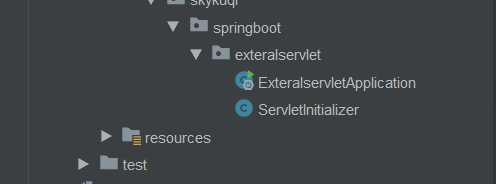
--创建项目webapp路径及web-XML文件: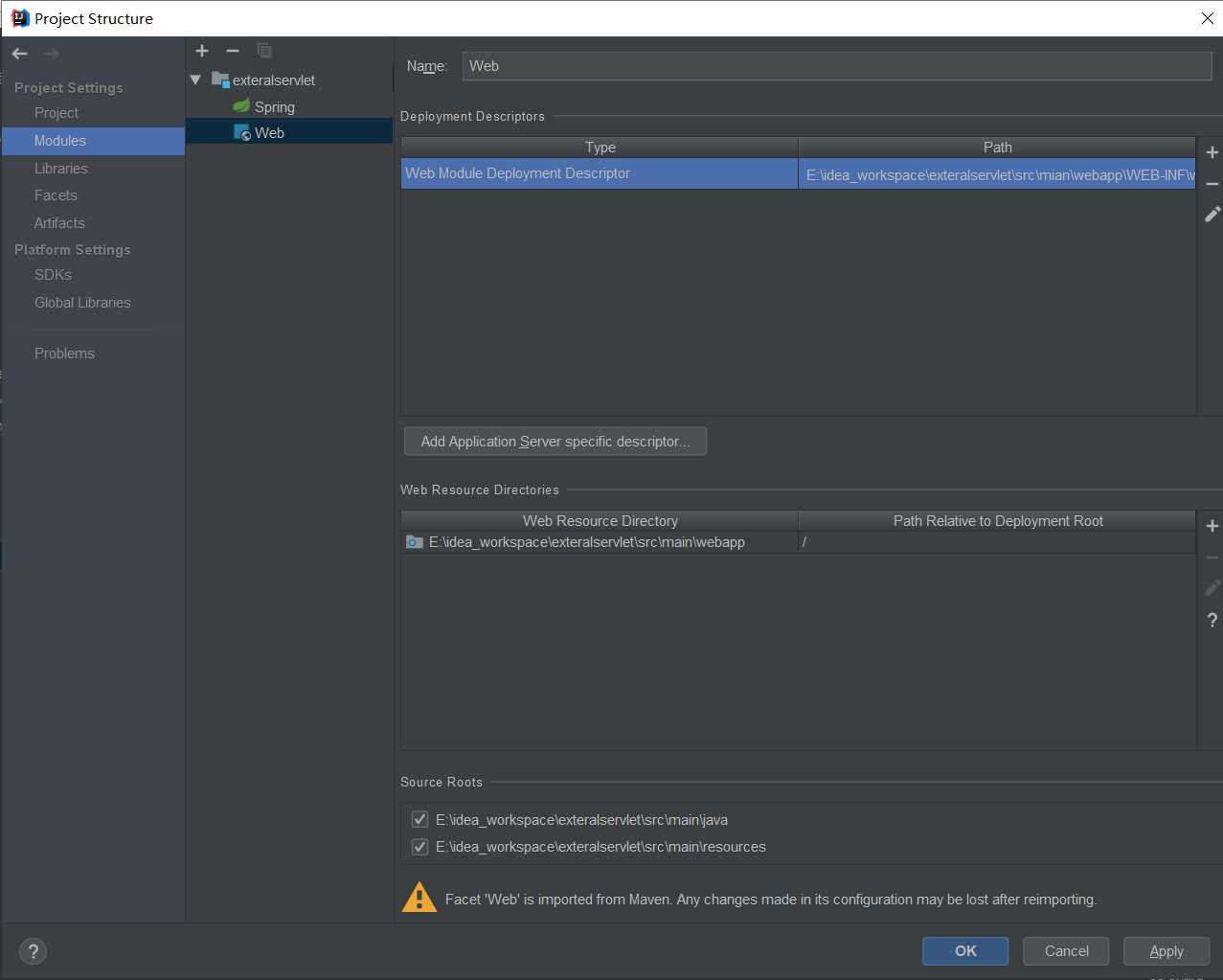
--部署Tomcat服务器: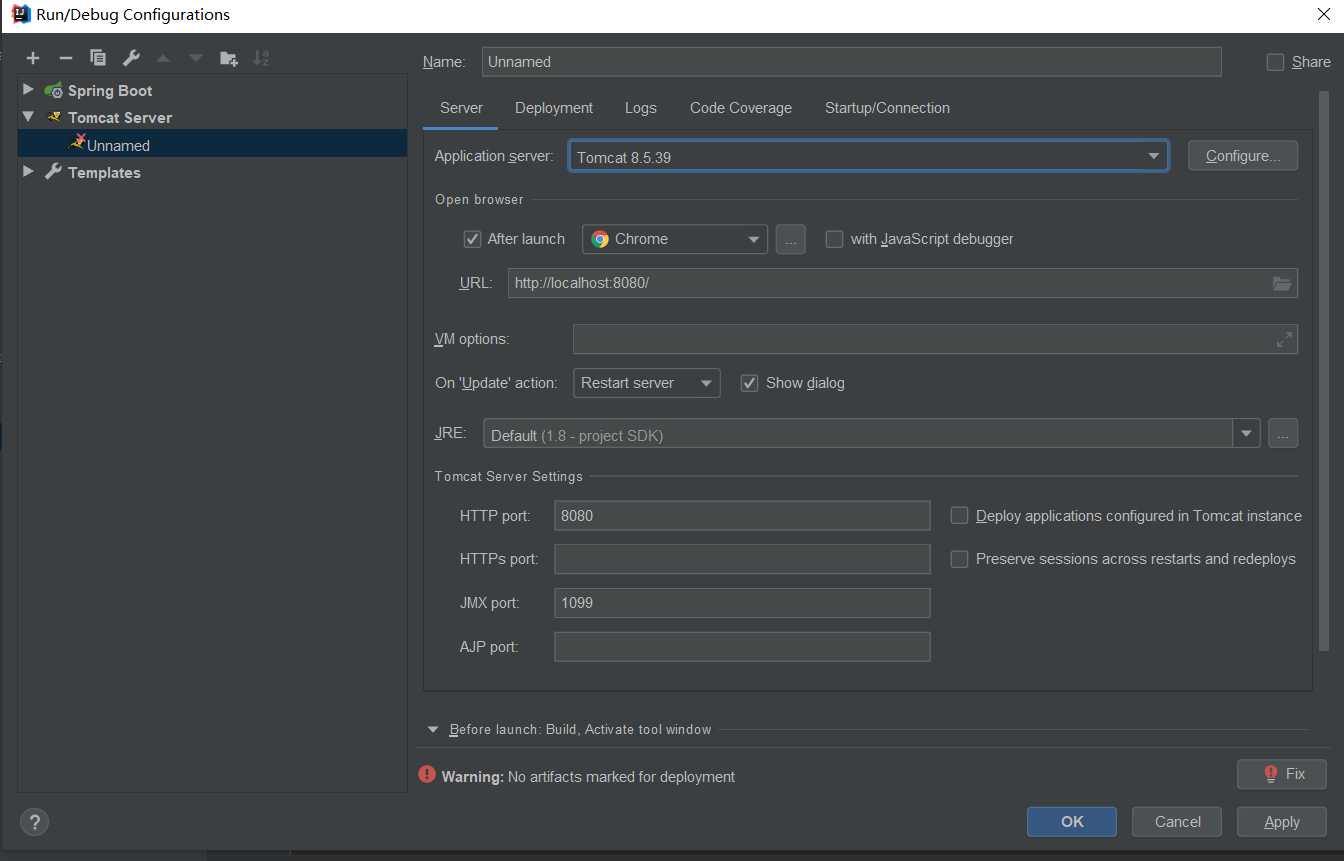
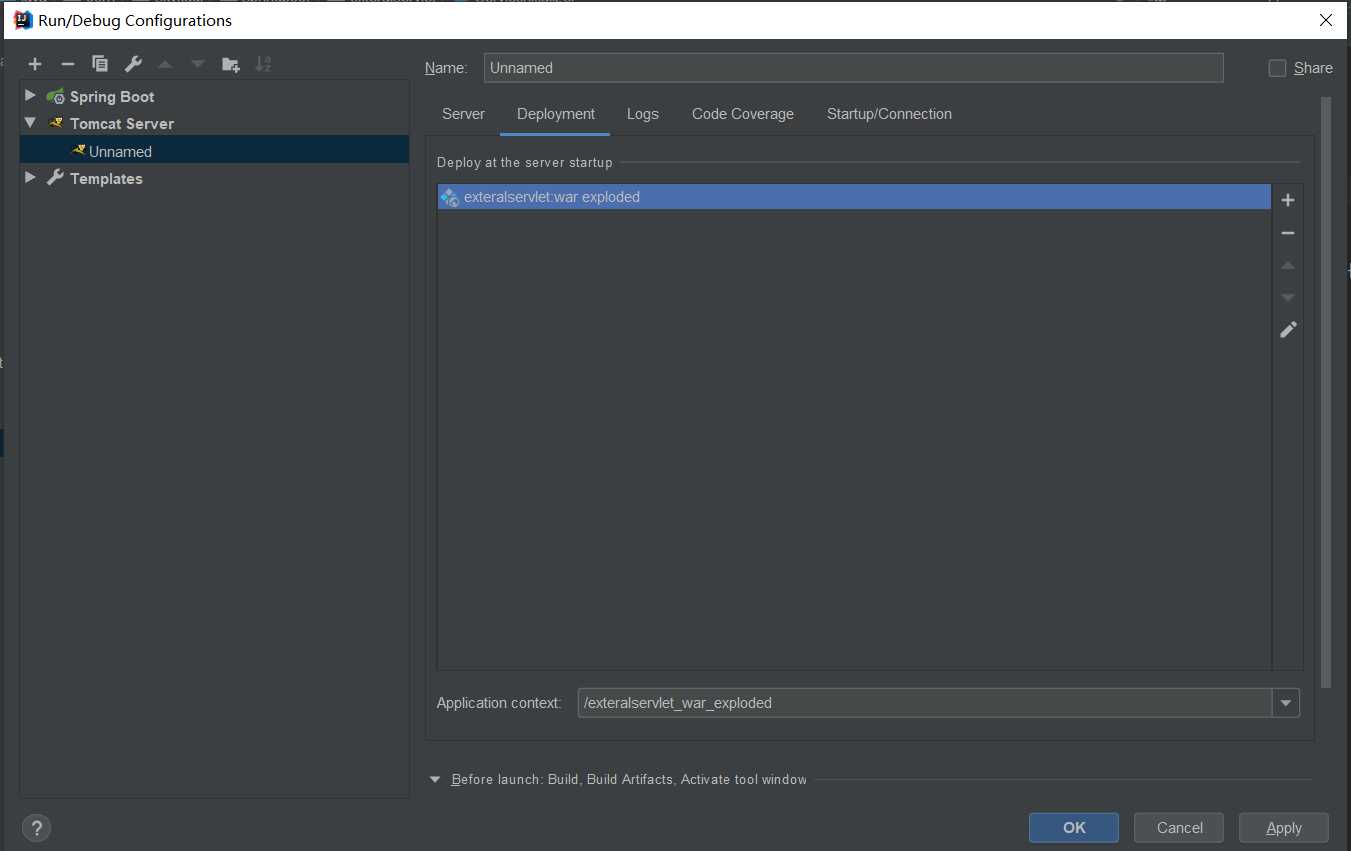
--创建步骤:
1.必须创建一个war项目;
2.将嵌入式的Tomcat指定为provided
1 <dependency>
2 <groupId>org.springframework.boot</groupId>
3 <artifactId>spring-boot-starter-web</artifactId>
4 </dependency>
5 <dependency>
6 <groupId>org.springframework.boot</groupId>
7 <artifactId>spring-boot-starter-tomcat</artifactId>
8 <scope>provided</scope>
9 </dependency>
3.必须编写一个SpringBootServletInitializer的子类,目的就是调用config方法
1 package com.skykuqi.springboot.exteralservlet;
2
3 import org.springframework.boot.builder.SpringApplicationBuilder;
4 import org.springframework.boot.web.support.SpringBootServletInitializer;
5
6 public class ServletInitializer extends SpringBootServletInitializer {
7
8 @Override
9 protected SpringApplicationBuilder configure(SpringApplicationBuilder application) {
10 //传入SpringBoot应用的主程序
11 return application.sources(ExteralservletApplication.class);
12 }
13
14 }
七.外置Servlet容器的启动原理
1.jar包:当我们的应用是使用SpringBoot的jar包形式的话,我们可以直接通过执行SpringBoot主类的main方法,启动IOC容器,创建嵌入式的Servlet容器;
2.war包:启动服务器,服务器启动SpringBoot应用,启用IOC容器:
3.在Servlet3.0中有一项规范: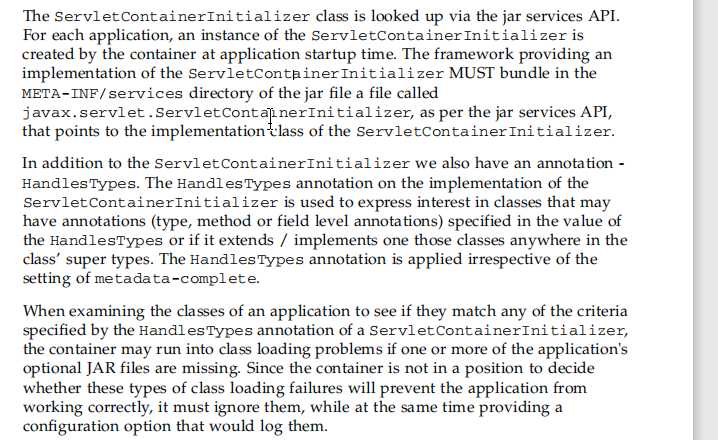
(1)服务器启动(web应用启动)会创建当前web应用里面每一个jar包里面ServletContainerInitializer的实例;
(2)ServletContainerInitializer的实现必须放在META-INF/services文件夹下,该文件夹下还必须有一个文件名为javax.servlet.ServletContainerInitializer的文件,文件的内容就是ServletContainerInitializer实现的全类名.
(3)可以使用@HandlesTypes注解来实现,容器在应用启动的时候,加载我们所感兴趣的类.
4.启动流程:
(1)启动Tomcat服务器,Spring的Web模块中存在该文件:

(2)SpringServletContainerInitializer将@HandlesTypes(WebApplicationInitializer.class)所标注的所有这个类型的类都传入到onStartup方法的集合中为这些不是接口不是抽象类类型的类创建实例;
(3)每一个WebApplicationInitializer的实现类都调用自己的onStartup方法.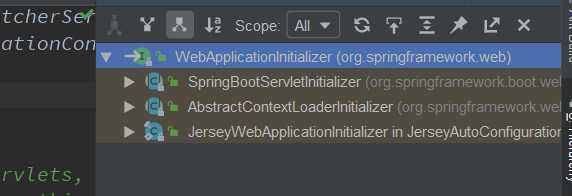
(4)相当于我们的SpringServletContainerInitializer的类会被创建对象,并执行onStartup方法;
(6)SpringServletContainerInitializer执行onStartup的时候会创建容器
1 protected WebApplicationContext createRootApplicationContext(
2 ServletContext servletContext) {
3 SpringApplicationBuilder builder = createSpringApplicationBuilder();
4 StandardServletEnvironment environment = new StandardServletEnvironment();
5 environment.initPropertySources(servletContext, null);
6 builder.environment(environment);
7 builder.main(getClass());
8 ApplicationContext parent = getExistingRootWebApplicationContext(servletContext);
9 if (parent != null) {
10 this.logger.info("Root context already created (using as parent).");
11 servletContext.setAttribute(
12 WebApplicationContext.ROOT_WEB_APPLICATION_CONTEXT_ATTRIBUTE, null);
13 builder.initializers(new ParentContextApplicationContextInitializer(parent));
14 }
15 builder.initializers(
16 new ServletContextApplicationContextInitializer(servletContext));
17 builder.contextClass(AnnotationConfigEmbeddedWebApplicationContext.class);
18 builder = configure(builder);
19 SpringApplication application = builder.build();
20 if (application.getSources().isEmpty() && AnnotationUtils
21 .findAnnotation(getClass(), Configuration.class) != null) {
22 application.getSources().add(getClass());
23 }
24 Assert.state(!application.getSources().isEmpty(),
25 "No SpringApplication sources have been defined. Either override the "
26 + "configure method or add an @Configuration annotation");
27 // Ensure error pages are registered
28 if (this.registerErrorPageFilter) {
29 application.getSources().add(ErrorPageFilterConfiguration.class);
30 }
31 return run(application);
32 }
--将创建RootApplicationContext容器,在创建容器时会进行如下操作:
a.创建SpringApplicationBuilder
b.在18行调用了configer(),将SpringBoot的主程序类传入了进来
c.使用builder创建一个Spring应用
标签:beans assert cli setattr dde 生效 private either lse
原文地址:https://www.cnblogs.com/skykuqi/p/12000060.html